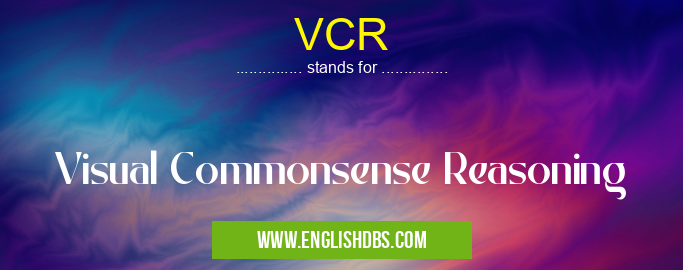What does VCR mean in UNCLASSIFIED
Visual Commonsense Reasoning (VCR) is a natural language processing (NLP) task that involves answering questions about images based on common sense knowledge. It differs from traditional image captioning or question answering tasks by requiring the machine to understand the visual content and apply real-world knowledge to make inferences.

VCR meaning in Unclassified in Miscellaneous
VCR mostly used in an acronym Unclassified in Category Miscellaneous that means Visual Commonsense Reasoning
Shorthand: VCR,
Full Form: Visual Commonsense Reasoning
For more information of "Visual Commonsense Reasoning", see the section below.
- Visual Commonsense Reasoning (VCR) is an artificial intelligence (AI) task that involves understanding the commonsense knowledge and reasoning processes of humans. It evaluates AI systems' ability to interpret visual information and make inferences about events and relationships in a scene.
What is VCR?
- VCR assesses AI models' understanding of everyday scenarios by presenting them with images and questions that require them to:
- Identify objects, actions, and relationships in the image.
- Apply commonsense knowledge to make inferences and answer the questions.
- Reason about the intentions, motivations, and emotions of individuals in the scene.
Key Features of VCR
- Diverse Scenarios: VCR uses a wide range of images depicting real-world situations, ensuring that AI models can handle various contexts.
- Complex Questions: Questions in VCR are designed to test AI models' ability to understand complex relationships, draw inferences, and reason about causality.
- Evaluation Metrics: VCR employs metrics such as accuracy and F1 score to measure the performance of AI models in understanding the commonsense aspects of visual scenes.
Essential Questions and Answers on Visual Commonsense Reasoning in "MISCELLANEOUS»UNFILED"
What is Visual Commonsense Reasoning (VCR)?
Why is VCR important?
VCR is important because it bridges the gap between vision and language by enabling machines to process and reason about visual information using commonsense knowledge. It has applications in various fields, such as computer vision, natural language understanding, and artificial intelligence.
How does VCR work?
VCR typically involves a model that is trained on a dataset of images and corresponding questions and answers. The model learns to extract visual features from the images and use these features, along with its knowledge of commonsense, to generate answers to the questions.
What are the challenges in VCR?
Some of the challenges in VCR include handling complex visual scenes, understanding abstract concepts, and dealing with incomplete or ambiguous information. Additionally, the need for extensive datasets and the biases inherent in training data can pose challenges.
What are the applications of VCR?
VCR has applications in various domains, including:
- Image search: Enhancing the accuracy of image search results by providing more relevant and contextually appropriate results.
- Object detection: Improving object detection by leveraging commonsense knowledge to identify objects in complex scenes.
- Question answering: Providing more informative and accurate answers to questions about visual content.
Final Words:
- VCR (Visual Commonsense Reasoning) is an essential benchmark for evaluating the progress of AI systems in understanding and reasoning about visual information. By assessing AI models' ability to handle everyday scenarios, VCR helps drive advancements in AI's ability to interact with the world in a more intelligent and humanlike manner.
VCR also stands for: |
|
| All stands for VCR |
